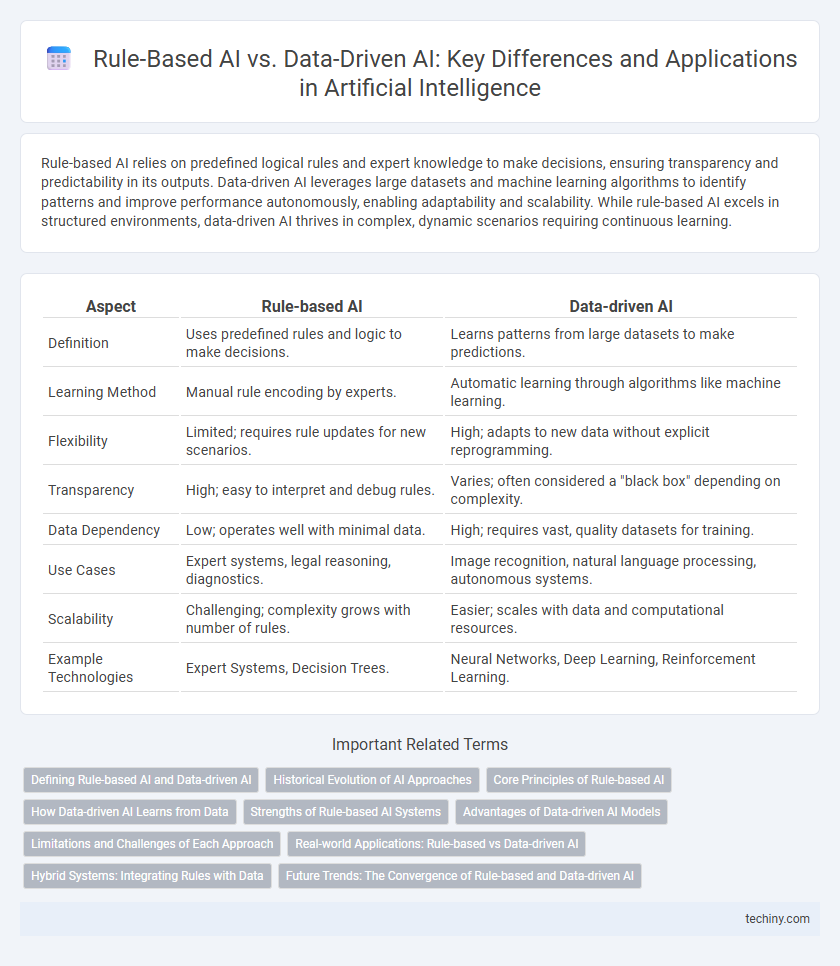Rule-based AI relies on predefined logical rules and expert knowledge to make decisions, ensuring transparency and predictability in its outputs. Data-driven AI leverages large datasets and machine learning algorithms to identify patterns and improve performance autonomously, enabling adaptability and scalability. While rule-based AI excels in structured environments, data-driven AI thrives in complex, dynamic scenarios requiring continuous learning.
Table of Comparison
| Aspect | Rule-based AI | Data-driven AI |
|---|---|---|
| Definition | Uses predefined rules and logic to make decisions. | Learns patterns from large datasets to make predictions. |
| Learning Method | Manual rule encoding by experts. | Automatic learning through algorithms like machine learning. |
| Flexibility | Limited; requires rule updates for new scenarios. | High; adapts to new data without explicit reprogramming. |
| Transparency | High; easy to interpret and debug rules. | Varies; often considered a "black box" depending on complexity. |
| Data Dependency | Low; operates well with minimal data. | High; requires vast, quality datasets for training. |
| Use Cases | Expert systems, legal reasoning, diagnostics. | Image recognition, natural language processing, autonomous systems. |
| Scalability | Challenging; complexity grows with number of rules. | Easier; scales with data and computational resources. |
| Example Technologies | Expert Systems, Decision Trees. | Neural Networks, Deep Learning, Reinforcement Learning. |
Defining Rule-based AI and Data-driven AI
Rule-based AI relies on explicitly programmed rules and logical conditions to make decisions, using predefined knowledge bases and if-then statements for problem-solving. Data-driven AI employs machine learning algorithms that analyze large datasets to identify patterns and make predictions without explicit rules. Rule-based systems excel in deterministic environments, while data-driven models adapt dynamically to new information.
Historical Evolution of AI Approaches
Rule-based AI originated in the 1950s with expert systems that relied on predefined logical rules to mimic human decision-making. Data-driven AI gained prominence in the 1990s as machine learning algorithms leveraged large datasets to identify patterns and improve performance autonomously. The historical evolution reflects a shift from symbolic reasoning to statistical methods, driven by advances in computational power and data availability.
Core Principles of Rule-based AI
Rule-based AI operates on explicitly defined rules and logical conditions, using symbolic reasoning to emulate human decision-making processes. It relies on a knowledge base composed of if-then rules that govern system behavior without requiring large datasets. This approach ensures transparency and predictability by applying deterministic algorithms to structured information.
How Data-driven AI Learns from Data
Data-driven AI leverages algorithms such as neural networks and machine learning models to identify patterns and extract insights from vast datasets. It continuously refines its predictions by training on labeled or unlabeled data, enabling adaptive decision-making without explicit programming. This approach contrasts with rule-based AI, as data-driven systems improve performance through experience rather than predefined rules.
Strengths of Rule-based AI Systems
Rule-based AI systems excel in environments requiring clear, interpretable decision-making through predefined logic and explicit rules, ensuring transparency and ease of debugging. They perform reliably in domains with well-understood expertise, such as medical diagnostics or regulatory compliance, where consistency and adherence to established standards are paramount. The deterministic nature of rule-based AI provides predictable outcomes, reducing risks in critical applications by avoiding ambiguities inherent in data-driven approaches.
Advantages of Data-driven AI Models
Data-driven AI models excel in adaptability by learning patterns from vast datasets, enabling them to improve performance over time without explicit programming. These models can uncover complex relationships and subtle nuances within data that rule-based systems may overlook. Their scalability allows deployment across diverse applications, from natural language processing to image recognition, providing more accurate and flexible solutions.
Limitations and Challenges of Each Approach
Rule-based AI struggles with scalability and adaptability due to its reliance on predefined rules, making it inefficient for handling complex or dynamic environments. Data-driven AI requires vast amounts of high-quality data and significant computational resources, facing challenges with bias, interpretability, and generalization beyond training datasets. Both approaches present trade-offs between control and flexibility, impacting their effectiveness across different AI applications.
Real-world Applications: Rule-based vs Data-driven AI
Rule-based AI excels in structured environments like expert systems for medical diagnosis and fraud detection by applying predefined rules, ensuring transparency and interpretability. Data-driven AI leverages machine learning algorithms to analyze vast datasets, enabling adaptive solutions in image recognition, natural language processing, and autonomous driving. Combining rule-based logic with data-driven models enhances decision-making accuracy and robustness in complex real-world applications.
Hybrid Systems: Integrating Rules with Data
Hybrid AI systems combine rule-based logic with data-driven learning to enhance decision-making accuracy and adaptability. By integrating symbolic reasoning structures and machine learning models, these systems leverage explicit knowledge representation alongside pattern recognition capabilities. This fusion enables applications like natural language processing and autonomous systems to achieve improved interpretability and performance in complex environments.
Future Trends: The Convergence of Rule-based and Data-driven AI
Future trends in artificial intelligence highlight a growing convergence between rule-based AI and data-driven AI, integrating symbolic reasoning with machine learning techniques to enhance decision-making accuracy and interpretability. Hybrid AI systems leverage explicit knowledge representations alongside large datasets to adapt dynamically while maintaining transparency and explainability. This synergy promises advancements in autonomous systems, natural language understanding, and complex problem-solving across diverse industries.
Rule-based AI vs Data-driven AI Infographic

 techiny.com
techiny.com